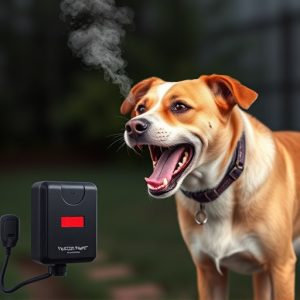Anti-Barking Devices: Humane Solutions for Noise Pollution in Neighborhoods
Excessive dog barking disrupts neighborhoods, prompting the search for humane solutions like Dog Rep…….
Excessive dog barking disrupts neighborhoods, prompting the search for humane solutions like Dog Repellent Devices (DRDs). Compliance Testing is crucial to ensure DRDs' safety and effectiveness, adhering to international standards and methodologies. This process checks sound pressure levels and selectivity to prevent harm and minimize false triggers. By understanding local regulations and community concerns, compliance testing helps implement balanced anti-barking solutions, fostering peaceful co-existence between residents and dog owners.
In many neighborhoods, excessive dog barking has become a growing concern, impacting quality of life and leading to community conflicts. This article explores an innovative solution: anti-barking devices designed to address noise pollution without causing harm to dogs. We delve into the science behind dog behavior, the necessity for effective yet humane repellents, and the rigorous testing standards ensuring their compliance. Understanding these solutions is crucial for fostering peaceful coexistence between neighbors and canine companions.
- Understanding Dog Behavior and Noise Pollution
- The Need for Effective and Humane Dog Repellent Devices
- Methodology and Compliance Testing Standards
- Implementing and Regulating Anti-Barking Solutions in Neighborhoods
Understanding Dog Behavior and Noise Pollution
Dog barking is a natural form of communication, but excessive or unnecessary barking can be a significant nuisance for neighbors. Understanding dog behavior is crucial in addressing this issue. Dogs bark for various reasons—as a warning, to express excitement, fear, or frustration. Identifying the trigger for a dog’s barking is essential in finding an effective solution. Many modern dog repellent devices aim to address noise pollution by utilizing specific technologies designed to stop or deter barking without causing harm to the animal.
Compliance testing for these devices is vital to ensure they are safe and humane. Dog Repellent Devices (DRDs) should be rigorously tested to guarantee their effectiveness while adhering to ethical standards. The process involves evaluating the device’s impact on dog behavior, its reliability in different scenarios, and its overall safety for both dogs and humans. By understanding dog behavior and implementing well-tested DRDs, communities can foster a more harmonious environment where pets can communicate without causing disturbances.
The Need for Effective and Humane Dog Repellent Devices
In many neighborhoods, excessive dog barking has become a persistent issue, disrupting peace and harmony among residents. This problematic behavior often arises from various factors, such as fear, anxiety, or simply overstimulation, leading dogs to bark excessively. The need for effective and humane solutions is more pressing than ever. Traditional methods like shouting or physical punishment can cause further distress and may even exacerbate the behavior.
As a result, there is a growing demand for innovative Dog Repellent Devices that can address this issue humanely. These devices are designed to discourage barking without causing harm or stress to the animals. Compliance testing plays a crucial role in ensuring these products meet specific standards, guaranteeing their effectiveness and safety. By employing such technologies, neighborhoods can foster a more peaceful environment while maintaining the well-being of both residents and canines.
Methodology and Compliance Testing Standards
The effectiveness of an anti-barking device is gauged through rigorous Methodology and Compliance Testing Standards. These tests ensure that the dog repellent device operates within safe parameters, respects animal welfare guidelines, and complies with relevant regulations. Dog Repellent Device Compliance Testing involves assessing the sound pressure level (SPL) generated by the device to confirm it falls below harmful decibel levels for canine hearing. This process is crucial in mitigating potential audiological damage to both targeted and non-target dogs within the vicinity.
Furthermore, testing methodologies evaluate the device’s selectivity, ensuring it only activates in response to specific barking patterns, thereby minimizing false triggers and unnecessary distress to pets or neighbors. The end goal of these standards is to create a harmonious living environment where dog owners can address unwanted barking responsibly while maintaining peaceful relations within the neighborhood.
Implementing and Regulating Anti-Barking Solutions in Neighborhoods
Implementing anti-barking devices in neighborhoods requires a balanced approach, considering both dog owners’ rights and the well-being of the community. The first step is to understand local ordinances and laws regarding noise pollution and pet ownership. Many areas mandate specific levels of compliance for these devices, ensuring they meet certain criteria for effectiveness and humane operation. Dog repellent devices, such as ultrasonic bark deterrents, are popular choices due to their non-invasive nature and ability to reduce barking without causing harm.
Compliance testing plays a crucial role in regulating these solutions. Regular assessments ensure that the devices function as advertised and remain within safe operating parameters. This process involves evaluating sound levels, sensitivity triggers, and any potential side effects on both dogs and humans. By adhering to strict compliance standards, neighborhood residents can benefit from reduced noise disturbance while respecting the needs of pet owners who rely on these devices for their canine companions’ well-being.
Anti-barking devices offer a promising solution to address neighborhood noise pollution caused by dog barking. By understanding canine behavior and implementing effective, humane methods, these tools can foster peaceful living environments for all residents. Rigorous compliance testing ensures the safety and reliability of these devices, making them viable options for communities seeking harmony. Through proper regulation and responsible use, anti-barking solutions can navigate a balance between pet ownership and neighborhood serenity.


